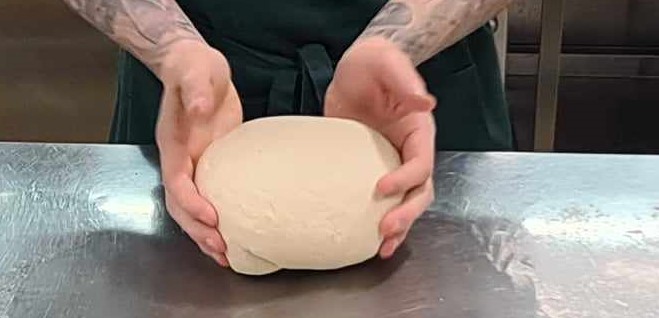World Pizza Day. Yep, it’s a thing! So rather than ordering in this Friday 9 February, why not try your hand at creating the perfect dough at home and cover with your fave toppings.
Whether you’re a pineapple advocate or have a strict no-pineapple policy, your home-made dough will be your oyster this World Pizza Day. So go nuts!
Here are some carefully curated tips from our Hospitality Trainer Anthony Patterson, who’s letting you in on a few little secrets…
First, let’s meet Anthony!

Anthony has been working as a chef since 2010 and has a passion for all things food. Throughout his career he has worked at some amazing restaurants to develop his signature style of cooking, but more importantly, he loves everything wheat. There’s not a day that goes by that he doesn’t eat bread, pasta or beer (yes, you read that right) and in his downtime he spends most of it playing with flours to produce a suite of reliable recipes.
The Main Players
Flour
When baking, flour is probably the first ingredient that pops up, and out of the many varieties of flours you can utilize in your baking, wheat flour will be the most commonly called on in recipes.
Wheat flour is the perfect grain to use for baking breads (this includes pizza dough), different varieties of wheat contain different amounts of protein (gluten) from weak to strong. We usually rely on strong flour, also called bakers flour, in most recipes when baking breads. With higher protein come stronger gluten bonds, and more gluten bonds mean more networks to trap Co2 gas produced by yeast. This relationship between yeast producing Co2 and gluten networks trapping co2 yields lighter bread and the chance to create some fantastic flavours.
Water
Water is a raw necessity when it comes to bread production, but how often do you consider the type of water you use on your breads? There are big differences between tap vs. filtered water and the results will surprise you!
When baking bread always stick to filtered water, tap water contains chemicals that inhibit bacterial growth which is great when you don’t want to get a crook tummy, but for bread we want an environment that supports rapid growth of yeast bacteria.
Yeast
When it comes to yeast the three most common types use in recipes are dried, fresh or a starter. Each of these three types of yeast all have uses, for this course we will be baking with the most readily and called for of the bunch, dried yeast.
There are some amazing things that dried yeast can do given the right environments and over the next two days you’ll find out first-hand how to use dried yeast most effectively to achieve maximum flavor and rise.
Yeast feed off the basic sugars from the conversion of starches into sugars, producing Co2 and alcohol as by-products. Brewer’s yeast produce more alcohol and less Co2, whereas baker’s yeast produces more Co2 and less alcohol.
Salt
Other than just boosting flavor, salt provides the support to promote a stronger loaf. Salt tightens the gluten structure, this tightening gives strength to the gluten, enabling the dough to efficiently hold carbon dioxide. When salt is left out the resulting dough is slack and stick in texture making work-up difficult and bread that lacks volume. The lesson here is always season your food, it’ll thank you for it.
Kneading
In simple terms, kneading is the act of pulling, moving and stretching dough to develop and strengthen gluten bonds. Kneading, in turn, creates more networks to trap co2 and give overall structure to a dough.

Windowpane test
A great way to test if you’ve developed enough gluten in the dough for resting, shaping, and baking is to conduct a windowpane test. A windowpane test is when you take a small portion of dough and try to stretch it to the point that you can see through it. If the dough breaks and falls apart before you can see through it, more kneading will have to take place.
Proofing
Proofing dough has multiple benefits in regard to a final baked product. By proofing over time, which can be anywhere from 1 – 36 hours and above, yeast is allowed to feast on simple sugars and produce co2. Another significant benefit for proofing is allowing the dough to rest. Resting relaxes the gluten proteins that are worked during kneading or shaping. A well-rested and proofed dough will lead to a baked good of the highest quality.
Knocking back dough
After the first proof, a dough will usually be around doubled in size, filled with co2. At this point, some doughs call for “knocking back”, this simple technique improves the overall outcome of a dough. Knocking back a dough releases and compresses co2 in the dough, evening out the internal structure, so gas bubbles are more or less the same size. This process should not be confused with kneading, as you will not be trying to develop the gluten further manually. Instead, knocking out excess co2 to make shaping the dough easier.
Foccacia/pizza dough recipe
- Makes 1 foccacia/pizza base
- 10 mins of prep
- 1-2 days resting
Ingredients
- 331g bread flour (100%)
- 227g filtered water (69%)
- 5g salt (1.5%)
- 1 tsp dry active yeast (5g) (1.5%)
- Olive oil for greasing
Method
STEP 1
In a large bowl or stand mixer mix all ingredients except the olive oil, turn the dough out onto a bench and knead lightly for 1 minute. Transfer dough into a lightly greased clean bowl and cover. Rest dough in a fridge for 12 – 36 hours.
STEP 2
Around 5 hours before you plan to cook, take dough out of the fridge and gently spread dough out into an olive oil greased tray. Cover with greased cling film lightly and allow to proof for 2 – 4 hours at room temperature until the dough has doubled in size.
Alternatively 2 hours proofing at 26 degrees
STEP 3
After dough has proofed top with desired toppings, dimple and bake for 15 -20 minutes at 200 degrees centigrade.